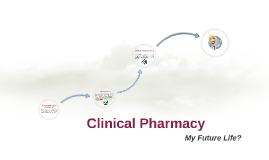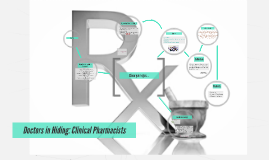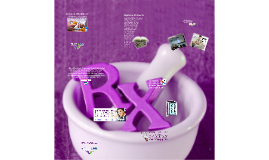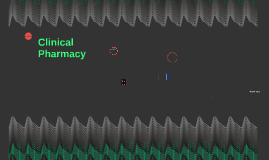Clinical Pharmacy
Transcript: Drug Effectiveness 12 Why Clinical Intervention? 15 Variability in Cost of Medications 28.5.2012 Increased Non-adherence to Medications 76 16 The scope of pharmacy practice has changed drastically over the past 4 decades especially in the field of patient care. Pharmacy Practices were transferred from dispensing of prescriptions to many clinical aspects. The terms clinical pharmacy, pharmaceutical care, patient counseling, patient education, patient care, drug therapy management, specialist clinical pharmacist etc are prevailing over dispensing of prescriptions. Is Antibiotic X Appropriate for Infection Y? Results of Nullified Clinical Intervention Why Patient Care? 1 Why Clinical Intervention? Patient Care Pharmaceutical Care Concor Capozide Marevan Rythonorm Aspocid Lanoxin Becozym Amaryl Vilatel 100 Other Patient care Activities Increased Cost of Treatment Inappropriate Medications Inappropriate Dose Regimen Increased Cost of Treatment Increased Teratogenicity Increased Medication errors. Increased ADRs. Increased Drug interactions. Increased Non adherence to medications Increased Relapsing Rate. Increased Readmission. Increased Morbidity and mortality. 5 7 17 The role of pharmacists in control and management of type 2 Diabetes Mellitus; a review of the literature Incidence of Medication Errors Other Patient care Activities Overall Clinical Intervention Agenda 1. Introduction and confirmation of patient. 2. Purpose of Patient Counseling 3. Disease 4. Data gathering 5. Medication name 6. Dosing regimen 7. Duration of therapy. 8. Difficulties or Precautions 9. Interactions 10. Storage 11. Goals of therapy and monitoring: 12. Check for understanding Increased Morbidity and Mortality 10 Inappropriate medications 77 Pharmacy practice is the discipline of pharmacy which involves developing the professional roles of pharmacists. 49 22 Other Patient care Activities Effect of patient counseling on quality of life of hemodialysis patients in India Increased ADRs 1. The medication is appropriate. 2. There is a clinical indication for each medication being taken. 3. All of the patient's medical conditions that can benefit from drug therapy have been identified. 4. The medication is effective. 5. The most effective drug product is being used. Figure 5: Irrational Dispensing 14 37 Increased Cost of Treatment Attends ward rounds with doctors for selecting and managing the pharmacotherapy of patients 103 D T P/s adherence Increased Drug Interactions Patient Education Pharmacotherapy Workup Definition of disease Risk factors of disease Causes of disease Prevention of disease Diagnosis of disease Treatment of disease Personal Follow up of patient Why Patient Care? 6 Why Clinical Intervention? The Patient's DRNs Why Clinical Intervention? Optimize therapy Reduce DTPs Improves adherence to medication Reduce complications. Reduce hospitalizations Decrease in expenses. Decrease the burden on the medical staff, and health care facilities. Pharmaceutical care Clinical interventions for first Prescription Patient Care Patient Counseling Patient Education Patient Monitoring Disease Management Clinics Pharmacotherapy Workup Monitoring Drug Effectiveness Monitoring Side Effects & Drug Interactions Extemporaneous pharmaceutical compounding. Sterile Products TDM DIPC Drug Distribution Pharmacovigilance Pharmacy & Therapeutic Committee Is X ADR for Y? Strands of Pharmacy Practice in Hospitals 42 Can drug X cause problem Y? Agenda Benefits of Patient Care Why Patient Care? Figure 2: Irrational Prescribing Evaluation of the community pharmacist´s behavior towards a prescription of antidiabetic and antiasthma drugs Increased Cost of Treatment Other Patient care Activities Figure 3: Irrational Prescribing Selection of Inappropriate Dose Regimen 4 nafarelin Examples of Patient Monitoring Head, Department of Pharmacy Practice and Clinical Pharmacy, FUE , Egypt Member, IC Commission, Accreditation Commission Pharmacy Education, USA Professor Faculty of Pharmacy, Cairo and King Saud Universities, Egypt and KSA Ex-Dean, Faculty of Pharmacy, Helwan University, Egypt Ex-Dean, Dubai Pharmacy College, Dubai, United Arab Emirates Ex-Dean, College of Pharmacy, Al Ain University for Science & Technology, UAE Ex-Dean, College of Dentistry, Al Ain University for Science & Technology, UAE Ex-Dean, College of Pharmacy and Nursing, Nizwa University, Oman Ex-Director, Al Ain University for Science & Technology, Abu-Dhabi, UAE 9 Strands of PP in Community Pharmacy Teratogenicity 52 Bacterial Resistance 73 Why Clinical Intervention? Increased Medication Errors 53 The process of providing written material to the patient to improve understanding of the disease, instruction about behaviors and activities and prevent complications. It must be simple and effective. Clinical Intervention What other drugs for patient not responded to X, Y, and Z for condition A Patient B? 13 Why Clinical Intervention? 94 The dosage of the medication is sufficient to achieve the

















